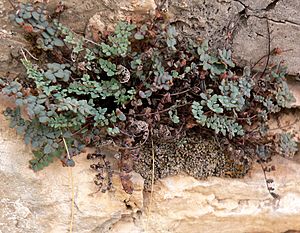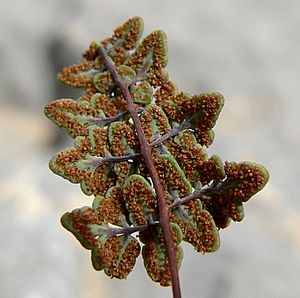Argyrochosma jonesii facts for kids
Quick facts for kids Argyrochosma jonesii |
|
|---|---|
 |
|
| Conservation status | |
| Scientific classification | |
| Genus: |
Argyrochosma
|
| Species: |
jonesii
|
| Synonyms | |
|
|
Argyrochosma jonesii, also called Jones' false cloak fern, is a type of fern. It grows naturally in the southwestern United States and Sonora, Mexico. This fern likes to grow on rocks that contain a lot of calcium, like limestone.
Its leaves are small and divided into many tiny parts. They feel a bit like leather and have dark stems connecting the leaf sections. Interestingly, unlike many ferns in its group, this one does not have a white, powdery coating on the underside of its leaves. Scientists first described this fern in 1917. Later, in 1987, they moved it to a new group called Argyrochosma, which means "false cloak ferns." This helped show they were different from other "cloak ferns."
Contents
What Does Jones' False Cloak Fern Look Like?
Roots and Stems
This fern has a short, horizontal rhizome, which is like an underground stem. Leaves grow very close together from this rhizome. The rhizome has thin, brown or reddish-brown scales that are about 5 to 7 millimeters long. These scales have smooth edges.
Leaves and Their Parts
The leaves of Jones' false cloak fern grow in clumps and can be 4 to 15 centimeters long. The leaf stalk, called the stipe, is dark brown or reddish-brown. It is smooth and round, about 0.75 to 1.5 millimeters wide. This stalk makes up about half to two-thirds of the leaf's total length.
The main part of the leaf, called the blade, is shaped like an egg or a spear. It is very divided, especially at the bottom. The blade is usually 3 to 7 centimeters long and 0.8 to 3 centimeters wide. The base of the blade is blunt, and the tip is pointed. The main stem of the leaf, called the rachis, is also dark. This dark color continues into the smaller leaf segments.
Leaflets and Texture
Each leaf usually has 4 to 6 pairs of main leaflets, called pinnae. These pinnae are divided into smaller, round or triangular leaflets called pinnules. The pinnules have blunt tips and heart-shaped or flat bases. The ones closest to the main leaf stem might be divided even further.
The leaf tissue is a dark blue-green color and feels leathery or slightly thick. You can't easily see the veins from the top of the leaf. Unlike many other ferns, this one does not have any hairs, scales, or a powdery coating on its leaves. The leaves also do not curl up when they get dry.
Reproduction: Spores
On fertile leaves, the sporangia (which hold the spores) are found near the edges of the leaf segments. Each sporangium contains 64 spores. The leaf segments only curl slightly, so the sporangia are easy to see. The fern does not have a false covering over its sporangia.
Jones' false cloak fern usually reproduces sexually. It has 54 chromosomes.
Similar Ferns
This fern looks a lot like A. lumholtzii, another fern found in Sonora. However, A. lumholtzii has darker leaf stalks and is less divided.
How Scientists Named This Fern
Scientists first described this fern in 1917. William Ralph Maxon named it Notholaena jonesii after Marcus E. Jones, who collected the first samples.
Over the years, scientists debated where this fern belonged. Some thought it should be in a different group. In 1950, Conrad Vernon Morton moved it to the Pellaea group. Then, in 1958, Philip A. Munz moved it to the Cheilanthes group.
Finally, in 1987, Michael D. Windham created a new group called Argyrochosma for ferns like this one. He then moved this fern into that group, giving it its current name, A. jonesii. More recently, in 2018, another scientist suggested moving it to the Hemionitis group, but its main name remains Argyrochosma jonesii.
Studies have shown that A. jonesii is closely related to A. lumholtzii. These two ferns are part of a larger group that also includes A. formosa and A. microphylla. All these ferns do not have the powdery coating that other ferns in the Argyrochosma group have.
Where Jones' False Cloak Fern Lives
You can find Argyrochosma jonesii in the United States in California, Arizona, Nevada, and southern Utah. It also grows in Sonora, Mexico. It is especially common in the Mojave and Sonoran Deserts. This fern likes to grow on cliffs and rocky ledges that have a lot of calcium, at elevations from 600 to 1900 meters (about 2,000 to 6,200 feet).
Protecting This Fern
According to the NatureServe conservation status system, A. jonesii is generally considered "apparently secure" (G4). This means it is not in immediate danger across its whole range. However, in Utah, it is considered "critically imperiled," meaning it is very rare and at high risk in that state.
Growing This Fern
If you wanted to grow this fern, it would prefer a lot of light. It also needs soil that is moist to dry and drains water well. It might also like soil with a high pH, which means it's more alkaline.



